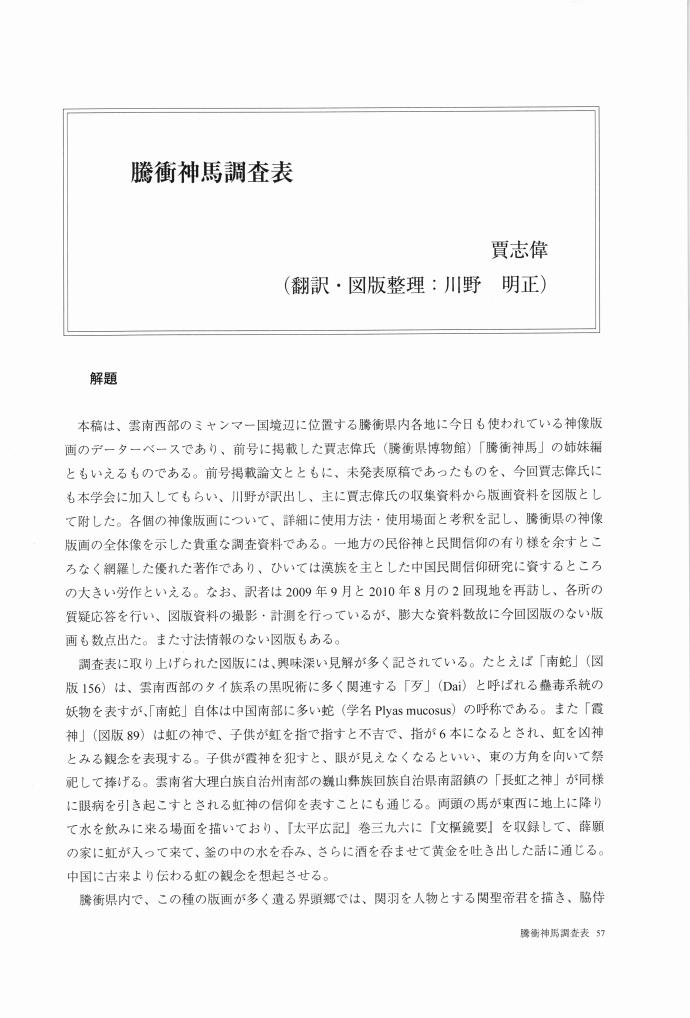- 著者
- 川野 明正
- 出版者
- 筑波大学比較民俗研究会
- 雑誌
- 比較民俗研究 : for Asian folklore studies
- 巻号頁・発行日
- no.19, pp.21-42, 2003-11-30
本論は、明末清初から中華人民共和国を含む現代にかけて、漢人の西南辺彊地域、とくに雲南地方への進出という歴史的側面から、西南非漢民族が行うとされる呪術的的民俗事象を主題とした考察を試みる。「走夷方」(ZouYiFang・漢語「ゾウイーファン」)と呼ばれる交易活動や物資輸送を目的とする漢人の雲南辺彊地区における旅行活動を取り上げ、走夷方を通じた民族間の出会いの局面に生じる民俗事象として、民族間呪術をめぐる伝承に注目し、それをめぐる漢人側の西南非漢民族のイメージがいかなる位相において表象されているかを考える。・・・
5 0 0 0 IR 漢語における「妖怪」概念 : 日・中・台の概念比較 (田島正行教授退職記念号)
- 著者
- 川野 明正
- 出版者
- 明治大学教養論集刊行会
- 雑誌
- 明治大学教養論集 (ISSN:03896005)
- 巻号頁・発行日
- no.547, pp.121-141, 2020-09
- 著者
- 川野 明正
- 出版者
- 明治大学教養論集刊行会
- 雑誌
- 明治大学教養論集 (ISSN:03896005)
- 巻号頁・発行日
- no.525, pp.103-122, 2017-09
3 0 0 0 IR 雲南省の神像呪符「甲馬子(ジャーマーツ)」に生きつづける中国祭祀版画の祈りの世界
- 著者
- 川野 明正
- 出版者
- 京都大学ヒマラヤ研究会・人間文化研究機構 総合地球環境学研究所「高所プロジェクト」
- 雑誌
- ヒマラヤ学誌 : Himalayan Study Monographs (ISSN:09148620)
- 巻号頁・発行日
- vol.11, pp.232-246, 2010-05-01
This thesis describes a kind of folk iconographical charm called as Jiamazi(甲馬子) of Yunnan in China. Jiamazi is used for prayer to various God, in case of many annual events and each folk religions service. This kind of prints is an important tool of the folk belief. They are burned and changed into smoke for praying to God and many evil and good spirits. It has been called as Zhima(紙馬), Shenma(神馬) and Jiama(甲馬) in other provinces, widely pervaded among various places. In some places, for example, Zhima means paper(紙) and horse(馬). This kind of prints accompanies with the names of horse. It contains important meanings, because the horse connects with between Gods and human being. Consequently, the horse symbolizes the character as media. Now, this kind of print disappeared in almost many places of China, by the extermination movement, for example, the "posijiu"(破四旧) and the "cultural revolution"(文化大革命), etc, against so called "feudalism superstition"(封建迷信) after People's Republic of China founded. Because it was considered to contain harmful thought and old custom by government. But, Jiamazi is not only still using now in Yunnan province, but also has most various contents in China. This thesis writes not only about historical origin and meaning of Chinese iconographical charm and Jiamazi charm, but also investigation report on Jiamazi, there are classified into four parts according to the purpose of use, that is, 1)praying to gods in daily life, 2)The annual events, 3)Religious service in Prayers house, 4)purification of disasters.
2 0 0 0 IR 沖縄村落守護シーサーの集落毎の設置様態 -シナ海石造獅子・狗犬文化圏の比較研究(5)
- 著者
- 川野 明正
- 出版者
- 明治大学教養論集刊行会
- 雑誌
- 明治大学教養論集 (ISSN:03896005)
- 巻号頁・発行日
- no.555, pp.(47)-(85), 2021-09-30
- 著者
- 川野 明正
- 出版者
- 明治大学教養論集刊行会
- 雑誌
- 明治大学教養論集 (ISSN:03896005)
- 巻号頁・発行日
- no.541, pp.147-171, 2019-09
- 著者
- 川野 明正
- 出版者
- 明治大学教養論集刊行会
- 雑誌
- 明治大学教養論集 (ISSN:03896005)
- 巻号頁・発行日
- no.547, pp.121-141, 2020-09
2 0 0 0 蠱毒伝承論--憑きもの的存在の言説にみる民俗的観念
- 著者
- 川野 明正
- 出版者
- 東京都立大学人文学部
- 雑誌
- 人文学報 (ISSN:03868729)
- 巻号頁・発行日
- no.331, pp.1-56, 2002-03
- 著者
- 川野 明正
- 出版者
- 明治大学人文科学研究所
- 雑誌
- 明治大学人文科学研究所紀要 (ISSN:05433894)
- 巻号頁・発行日
- vol.90, pp.425-453, 2023-03-31
1 0 0 0 OA 騰衝神馬調査表
- 著者
- 賈 志偉 川野 明正
- 出版者
- 一般社団法人 アジア民族文化学会
- 雑誌
- アジア民族文化研究 (ISSN:13480758)
- 巻号頁・発行日
- vol.10, pp.57-101, 2011-03-31 (Released:2020-05-16)
- 著者
- 川野 明正
- 出版者
- 東京理科大学
- 雑誌
- 理大科学フォーラム (ISSN:13461206)
- 巻号頁・発行日
- vol.31, no.12, pp.4-7, 2014-12
- 著者
- 川野 明正
- 出版者
- 首都大学東京都市教養学部人文・社会系
- 雑誌
- 人文学報 (ISSN:03868729)
- 巻号頁・発行日
- no.388, pp.1-28, 2007-03
